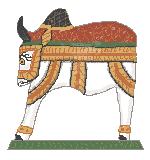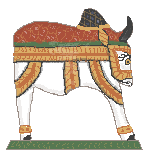- Bumba Meu Boi -
The
"Bumba-meu-boi" is is a very popular and widespread
comic-dramatic dance, a burlesque pantomime which performances
are traced to colonial times when it served as a diversion for
the slaves on the cattle estates is very popular in northeastern
Brazil.
 It
is a parade of human and animal characters to the sounds of music
and singing, performed in Brazil from north to south, with some
regional differences but keeping unchanged its essential structure.
It
usually happens from the middle of November to January 6th. It
started at the end of the 18th century in the coastal sugar plantations
and cattle ranches of northeastern Brazil and from there spread
to the interior of the country.
The
tale of the "Bumba-meu-boi" has many versions. The
general theme is a satire pitting the oppressive master against
a black slave, or sometimes a lowly worker, who gets into mischief
that causes the death or disfiguration of the master's prize
bull and finishes joyfully with the bull's miraculous resuscitation
and dance. Its name comes from the verb "bumbar", meaning
to beat up or against, and the expression is chanted by the crowd
as an invitation for the bull, or better, the men under the bull
costume to charge against them.
Normally,
there is a group of singers and the "chamador" or caller,
who introduces the characters with different songs. The instruments
used during this feast are the acoustic guitar, the accordion,
the Brazilian tambourine, and the "tamborim". Songs,
together with music, mark the steps of the show. There are songs
to thank the landlord and the space where the show is performed;
there are hymns to real people or to mythical characters, enriched
by several ethnical features.
It
is a parade of human and animal characters to the sounds of music
and singing, performed in Brazil from north to south, with some
regional differences but keeping unchanged its essential structure.
It
usually happens from the middle of November to January 6th. It
started at the end of the 18th century in the coastal sugar plantations
and cattle ranches of northeastern Brazil and from there spread
to the interior of the country.
The
tale of the "Bumba-meu-boi" has many versions. The
general theme is a satire pitting the oppressive master against
a black slave, or sometimes a lowly worker, who gets into mischief
that causes the death or disfiguration of the master's prize
bull and finishes joyfully with the bull's miraculous resuscitation
and dance. Its name comes from the verb "bumbar", meaning
to beat up or against, and the expression is chanted by the crowd
as an invitation for the bull, or better, the men under the bull
costume to charge against them.
Normally,
there is a group of singers and the "chamador" or caller,
who introduces the characters with different songs. The instruments
used during this feast are the acoustic guitar, the accordion,
the Brazilian tambourine, and the "tamborim". Songs,
together with music, mark the steps of the show. There are songs
to thank the landlord and the space where the show is performed;
there are hymns to real people or to mythical characters, enriched
by several ethnical features.
 In
some moments, the dance becomes a dramatic language. The costumes
are very colorful and ornated, covered by ribbons and mirrors
which reflect the lights and the environment, thus multiplying
the movements of dance and having the supernatural power to catch
the love of the public and to create a protection for the performers,
so that negative energies go back to those who have sent them.
The use of garlands, hats, ornaments has a dramatic function
and is based on a rigorous symbololism, hence it is not only
a scenic detail.
The
"bumba-meu-boi" has some close relatives in other regions
of Brazil. In northern Brazil there is the "boi-bumbá",
danced during the festival of "Bois de Parintins" and
in the island of Santa Catarina, in southern Brazil, there is
the "boi-de-mamão" ("mamão"
is the word for papaya). It's said that it receives the name
"boi-de-mamão" because originally a green papaya
was used as the bull's head.
In
some moments, the dance becomes a dramatic language. The costumes
are very colorful and ornated, covered by ribbons and mirrors
which reflect the lights and the environment, thus multiplying
the movements of dance and having the supernatural power to catch
the love of the public and to create a protection for the performers,
so that negative energies go back to those who have sent them.
The use of garlands, hats, ornaments has a dramatic function
and is based on a rigorous symbololism, hence it is not only
a scenic detail.
The
"bumba-meu-boi" has some close relatives in other regions
of Brazil. In northern Brazil there is the "boi-bumbá",
danced during the festival of "Bois de Parintins" and
in the island of Santa Catarina, in southern Brazil, there is
the "boi-de-mamão" ("mamão"
is the word for papaya). It's said that it receives the name
"boi-de-mamão" because originally a green papaya
was used as the bull's head. |
*
Back *
This
page was created on: January 24th 2002.
Last updated on: August 3rd 2003.
[
Site
index
] [ Home ]
~
Graphics by Irene ~
Bumba-meu-boi illustration by Michelle (Histórias e Músicas
Brasileiras - Marinheiro, Marinheiro. São Paulo. Ed.Abril
1982)
Green background by Grace ~ Yellow background
by The Mother Bear ~ Light background by Rajiv ~
Please, note that The Mother Bear is not on line anymore. |
|